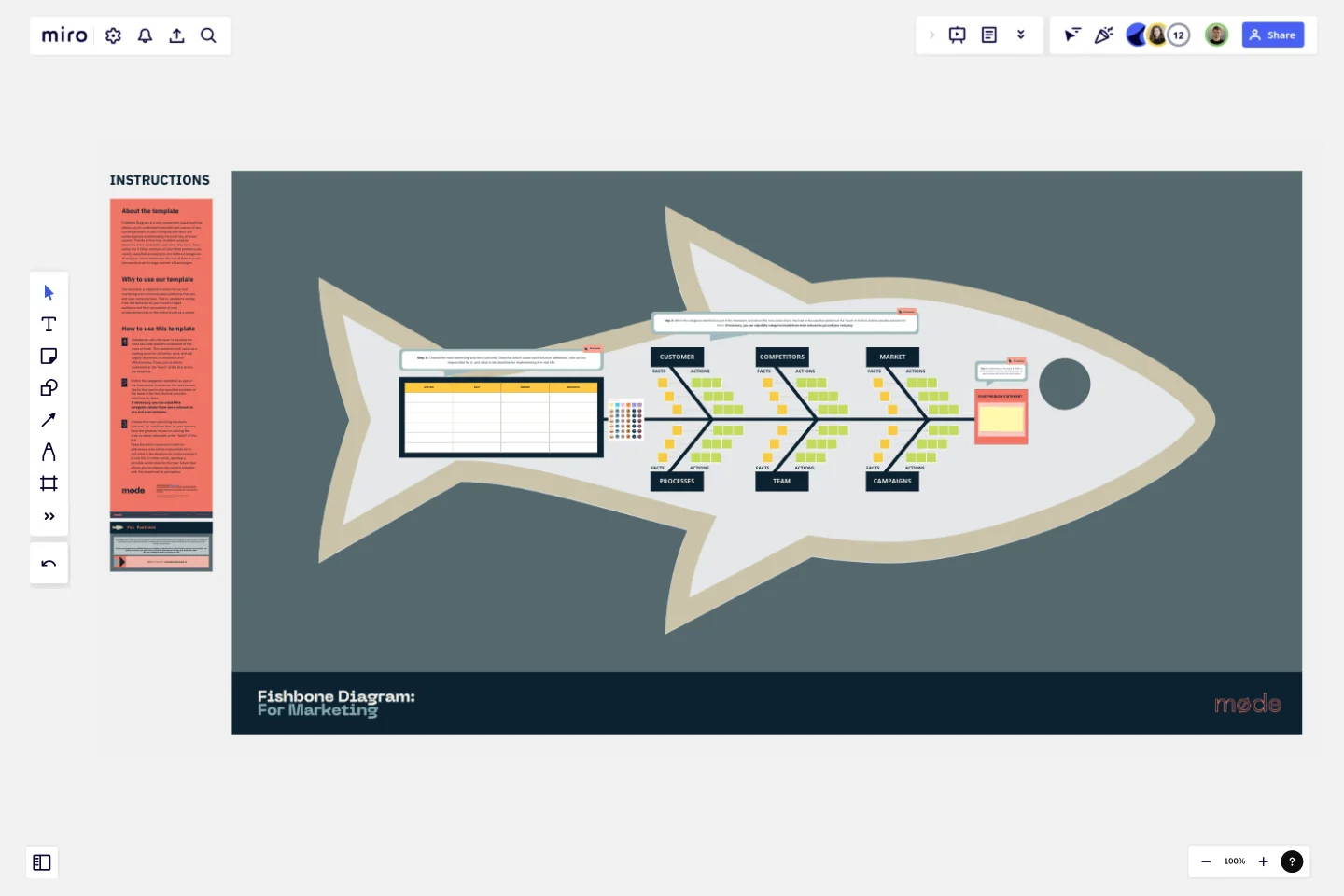Fishbone Diagram for Marketing
Fishbone Diagram is a very convenient visual tool that allows you to understand possible root causes of any current problem in your company and work out actions aimed at eliminating the most key of these causes.
Thanks to this tool, problem analysis becomes more systematic and takes less time. Also, unlike the 5 Whys method, all identified problems are clearly classified according to pre-defined categories of analysis, which eliminates the risk of their mutual intersections and a large number of tautologies.
Why to use our template
Our template is adapted to solve the current marketing and communication problems that you and your company face. That is, problems arising from the behavior of your brand's target audience and their perception of your products/services or the entire brand as a whole.
How to use this template
Collaborate with the team to develop the most accurate problem statement of the issue at hand. This statement will serve as a starting point for all further work and will largely determine its dynamics and effectiveness.
Within the categories identified as part of the framework, brainstorm the root causes (facts) that lead to the specified problem at the head of the fish. Outline possible solutions for them. If necessary, you can adjust the categories/make them more relevant to you and your company.
Choose the most promising solutions (actions), i.e. solutions that, in your opinion, have the greatest impact on solving the main problem indicated at the "head" of the fish. Describe which cause each solution addresses, who will be responsible for it, and what is the deadline for implementing it in real life. In other words, develop a possible action plan for the near future that allows you to improve the current situation with the brand and its perception.
This template was created by Mode Team.
Get started with this template right now.
Product Feature Presentation
Works best for:
Product Management, Planning
The Product Feature Presentation template aids product teams in showcasing product features and benefits effectively. By providing a structured framework for presenting key features, use cases, and value propositions, this template enables teams to communicate product functionality clearly and persuasively. With sections for creating feature demos, customer testimonials, and competitive differentiators, it facilitates engaging presentations that resonate with target audiences. This template serves as a powerful tool for driving product adoption and generating customer interest.
Timeline Template
Works best for:
Project Management, Flowcharts, Project Planning
A timeline displays a chronological order of important dates, and scheduled events. Timelines help product managers, project managers, and team members tell visual stories about progress and obstacles. Timelines enable teams to see at a glance what happened before, what progress is happening now, and what needs tackling in the future. Projects or products with specific purpose or deliverables should be based on a timeline to be successful. Use the timeline as a shared reference for start dates, end dates, and milestones.
PI Planning Template
Works best for:
Agile Methodology, Strategic Planning, Software Development
PI planning stands for “program increment planning.” Part of a Scaled Agile Framework (SAFe), PI Planning helps teams strategize toward a shared vision. In a typical PI planning session, teams get together to review a program backlog, align cross-functionally, and decide on the next steps. Many teams carry out a PI planning event every 8 to 12 weeks, but you can customize your planning schedule to fit your needs. Use PI planning to break down features, identify risks, find dependencies, and decide which stories you’re going to develop.
PERT Chart Template
Works best for:
Mapping, Project Planning
A Program Evaluation and Review Technique (PERT) diagram is used to plan projects efficiently. They help you set a clear timeline, plan out tasks and dependencies, and determine a critical path.
Product Development Gantt Chart
Works best for:
Gantt Chart, Planning
Developing a new product involves many steps and stakeholders. The Product Development Gantt Chart template helps you manage this complex process efficiently. Use it to outline each phase of development, set timelines, and assign responsibilities. Track progress and make adjustments as needed to stay on schedule. This template provides a clear visual representation, coordinating tasks for a successful product launch.
Go-to-Market GTM Template | Miro
Works best for:
Marketing, Desk Research, Strategic Planning
It doesn’t matter how innovative or effective a new product is — if it doesn’t get noticed and adopted by the right audience, the product won’t get off the ground. That’s where your Go-to-Market Strategy comes in. It’s a single resource that houses all of your research, insights, and data, and includes your business plan, target audience, marketing approach, and sales strategy. A GTM is especially important for any startups who grow fast, have to make split-second decisions, and have to be fully in sync.

